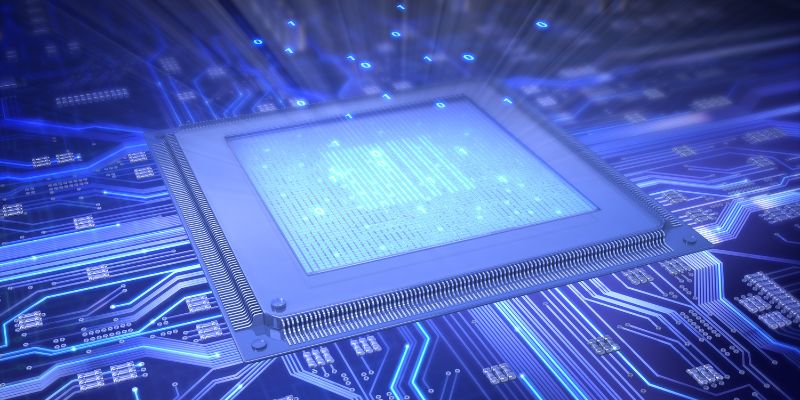The year 2023 was a fantastic fiscal year for Nvidia Corporation. Even with the US imposing sanctions on Nvidia trading semiconductor chips with one of its biggest markets, China, the semiconductor company still managed to post revenues of up to $26.97 billion, a 0.22% increase from 2022. If you are conversant with the happenings in the tech industry, you can probably infer why this is. For those who don’t, here’s a brief rundown.
In the past five years, NVIDIA (NVDA) has reported year-over-year (YOY) revenue growth of 20.61%, -6.81%, 52.73%, 61.40%, and 0.22% in 2019, 2020, 2021, 2022, and 2023 respectively. The COVID-19 pandemic greatly influenced that negative growth spell in 2020, yet the Silicon Valley giant recorded a 50% increase in stock prices the same year.
What has driven Nvidia’s recent success? Decades of pioneering development in semiconductor chip technology, particularly graphics processing units (GPUs), have now placed it as the frontrunner in the global chip market, well ahead of formidable competitors such as Intel and AMD.
That wasn’t always the case for Nvidia. In 2020, amidst the pandemic and peaking global demands for its high-performance GPUs and data centers, NVIDIA overtook Intel as the United States’ number-one chip manufacturer, and the company hasn’t looked back since. To help put this into perspective, let’s go back ten years.
Nvidia’s market capitalization at the close of 2014 was $10.89 billion, while that of Intel was $172.30 billion. Today, Nvidia ranks among the top five global tech companies with a market cap of $1.185 trillion, an astonishing 10,771% growth. On the other hand, Intel has had the good fortune of a 15.2% market cap increase in the past decade.
The disparity in fortunes of the two companies begs the question: what is Nvidia doing that other semiconductor companies aren’t, or rather, what are other companies doing that Nvidia corporation isn’t? To answer this, let’s look at the numerous applications of Nvidia technology that have made it such an industry leader.
Contents
- The Applications of Nvidia Semiconductor Chips
- Current Market for Nvidia Semiconductor Chips
- The Future of Semiconductor Chip Manufacturing?
- Outlook For the Secondary Market for Nvidia Semiconductor Chips
- Why Nvidia Stocks Are Rising
- Summary And Key Takeaways

The Applications of Nvidia Semiconductor Chips
Around the early 1990s, when contemporary tech companies such as AMD and Intel were gaining fast in the development of central processing units that fuelled the Internet age and PC era, Nvidia made a strong point of sticking with its research and development of graphics processing units (GPU) for video games and graphics-based computing. This will prove beneficial in the long run. In the following years, Nvidia would solidify its foothold as a pioneer in this sector with the 1998 release of its RIVA TNT graphics accelerator series.
Subsequently, in 1999, Nvidia released the GeForce series for consumer-grade hardware and electronics. The success of these GPUs in gaming applications paved the way for a contract from Microsoft to design the GPU for the Xbox and later on from Sony for the development of the PlayStation 3 gaming consoles.
Beyond gaming, the Nvidia corporation has also made considerable strides in AI innovation. The company’s recent growth owes a lot to the diversification of its GPU application from gaming to AI. A notable example of its success in this field is the adoption of over ten thousand Nvidia A100 chips in building the supercomputers that trained Open AI’s record-breaking large language model, ChatGPT. The success of this application, in particular, has made the company’s AI chips highly sought after by major tech companies such as Amazon, Alphabet (Google), Microsoft, and Meta for powering their varying AI initiatives.
Furthermore, professional and enterprise-grade Nvidia chips are widely adopted in various industry sectors for multiple reasons. In the crypto space, Nvidia has released custom GPU chips, such as the CMP series, making crypto mining much more feasible and accessible. Not only that, Nvidia’s high-end GPUs provide data center solutions for many global financial institutions, education and research institutes, tech corporations, and e-commerce businesses.
A Look at The Current Market for Nvidia Semiconductor Chips
Nvidia’s pioneering approach to semiconductor manufacturing has been one of the astounding peculiarities of the Silicon Valley giant. From the onset, founders Jensen Huang, Chris Malachowsky, and Curtis Priem intended it to be a fabless company. i.e., the company develops and designs GPUs but outsources the fabrication of the physical components to semiconductor foundries. This move has helped Nvidia focus its budget on semiconductor research and innovation, which has kept the company ahead in the GPU market. The dividends of this commitment are evidenced in the fact that Nvidia now controls 80% of the global market for discrete GPUs.
Only three years ago, Nvidia’s most significant revenue came from sales of PC gaming chips like the GeForce series. Today, however, the massive demand for chips with generative AI capabilities, such as the Hopper series, from the world’s leading industries has meant that most of the company’s revenue now comes from its high-performance GPU-powered data centers and server farms. So much so that of the $26.97 billion generated by Nvidia in 2023, $15 billion came from computing and networking, while about $11 billion came from the sale of graphics processors for PCs and gaming consoles.
In 2022, Nvidia revealed its flagship AI chip, the H100 hopper Tensor Core GPU, which has tested to be 4.5 times as fast as the previous generation A100 Ampere chip used in supercomputer applications like image recognition, image synthesis, and large language models training. Subsequently, big tech companies like Open AI, Meta, and Oracle have already stated their intentions to adopt the H100 GPU series in developing, training, and deploying generative AI. These developments position Nvidia Corporation to grow even more rapidly in the coming years as AI innovation drives global demand for its high-performance GPUs.

What Bodes for The Future of Semiconductor Chip Manufacturing?
Because semiconductor chips are the basic building blocks of everything electronics and hardware in the 21st century, the semiconductor industry is constantly affected by economic and political tensions in the global market. Here’s the deal with the semiconductor chips business as it is today.
Much of the design and development of semiconductors, from GPUs to CPUs and integrated graphics units, is done in the United States, thanks to leading companies such as NVIDIA, Qualcomm, Intel, AMD, and Broadcom. However, because most of these companies are fabless, the physical chips’ production phase is delegated to foundries based around the world in countries like Taiwan, China, Japan, and South Korea.
Taiwan’s TSMC boasts 59% of the global foundry market in this concentrated production market, producing chips for Apple, Nvidia, Qualcomm, and AMD. South Korea’s Samsung is the second biggest player, with a 15% share of global chip manufacturing. Japan follows closely in third place, with 13% of the production market. Why is this important for the future of semiconductor manufacturing?
The recent integration of Nvidia’s GPU chips in AI supercomputers used in technological, military, and medical research has led to a global horse race for who can develop better and more advanced semiconductor chips. For now, the United States leads the pack in this race, and it doesn’t look like it wants to give up the helm soon.
Amidst the bilateral strain in economic relations between the US and China, in October 2022, the US imposed bans on US companies trading certain semiconductors with China. While the Biden administration has implemented such actions in a bid for the US to maintain the upper hand in semiconductor design and the AI race, many industry leaders have argued the sanctions will drive China to double down on developing its own domestic semiconductor industry.
These sanctions may prove helpful to China down the line, as despite the US embargo limiting US-produced CPU and GPU chips from going towards the second biggest semiconductor importer in the world, there’s still a global scarcity of high-performance GPU chips that Nvidia alone cannot meet.
What’s The Outlook for The Secondary Market for Nvidia Semiconductor Chips
One of the major consequences of the global shortage of semiconductors is that electronics and PC manufacturers have turned to refurbished chips that are repaired and recycled for second use. Other than assuaging the strain of chip production on semiconductor companies, this secondary chip market promises lower production costs and more sustainable management of electronic waste.
The most significant factor driving the refurbishment of Nvidia GPUs has been the global demand for its parallel computing prowess in the fields of consumer electronics, telecommunications, healthcare, and vehicle automation. In the past few years, supply chain disruptions, natural disasters, trade tensions, and the pandemic have all hampered the production of new semiconductor chips worldwide. Not only that, with the scarcity expected to continue well into 2024, this could further solidify the market for an already burgeoning secondary chip market.
Many organizations will feel the squeeze of the supply chain disruptions, but ReluTech can bridge the gap. ReluTech sources refurbished NVIDIA GPUs that ship within the week. Check out ReluTech’s hardware solutions for all of your data center hardware sourcing needs. While GPU supplies remain low, ReluTech can supplement your needs with refurbished equipment.
Nevertheless, with the implementation of the CHIPS and Science Act by the Biden Administration, the primary market of US and foreign semiconductor manufacturers is poised to bounce back and ramp up production to meet global demand in 2024/2025.
Why Nvidia Stocks Are Rising
For Nvidia, one of the perks of dominating the discrete GPU market is that it stands to generate increased revenue from boosted price margins caused by scarcity in semiconductors. The company has carved a niche for itself in the semiconductor industry that others can’t easily replicate. Its Grace, Ampere, Hopper, and Ada Lovelace chip architectures are some of the world’s most advanced and sought-after; this has further buoyed investor confidence in the company’s value.
Hence, if you own a business implementing artificial intelligence technology or say you’re a speculative consumer, there’s a case to be made for long-term investment in Nvidia and associated stock.

Summary And Key Takeaways
The remarkable success of the Nvidia Corporation in the semiconductor market, particularly in 2023, can be attributed to the company’s decades-long commitment to pioneering GPUs for high-performance tasks like artificial intelligence, gaming, professional design, and simulation.
The company’s business model, coupled with its total dominance in the market for discrete GPU, has bolstered its position as the industry leader in AI solutions. Looking forward, even though the semiconductor industry faces protracted challenges stemming from political tensions, many hope the implementation of the CHIPS and Science Act in the US will help the all-essential semiconductor industry bounce back. ReluTech can helps organizations source for all major and minor OEM data center equipment. Request a quote now for the shortest lead times in the industry and see how much you can save on your IT infrastructure.